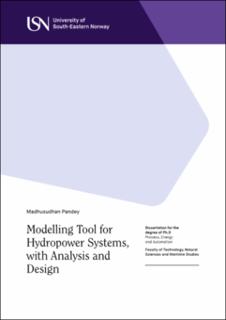Modelling Tool for Hydropower Systems, with Analysis and Design
Doctoral thesis
Published version
Permanent lenke
https://hdl.handle.net/11250/3093026Utgivelsesdato
2023-10-19Metadata
Vis full innførselSamlinger
Sammendrag
The increased use of renewable energy sources is due to an increasing global energy need, and to counter the effects of fossil fuels on the environment. Common renewable energy sources such as solar energy and wind energy are intermittent while hydropower is dispatchable. Norwegian water reservoirs provide almost half of Europe’s reservoir capacity and thus may play a significant role in balancing the variability caused by intermittent energy sources in the European interconnected grid.
The physics of generations, such as intermittent and dispatchable sources, and electric loads, are studied in the modern electric power grid. To improve the flexibility, reliability, and stability of the electricity grid in the future, we must incorporate innovative technology and market solutions. This necessitates contributions from a variety of disciplines, including physics, engineering, economics, and so on. The demand for and scope of contributions is so vast as a result of globalization that many people must participate. One approach to collaborate is to use open-source code.
In this thesis, the main contributions are developing mechanistic models of surge tanks and draft tubes for hydropower plants. These models are feature extensions of an existing open-source hydropower library — OpenHPL. The use of equation-based language Modelica is emphasized for developing modeling tools, e.g., OpenHPL. The developed models of surge tanks and draft tubes are studied for their flexible operation during electrical load rejections and acceptances in the intermittent power grid. Operational limits based on the design heights and the water mass oscillations are compared for open and closed surge tanks. Two types of draft tubes are studied, viz., conical draft tubes and Moody spreading pipes based on the pressure differences.
In addition, OpenHPL is also augmented with standard active power frequency control. Three types of power grid control are studied, viz., isochronous governor control, droop governor control, and automatic generation control (AGC) for an isolated power system. The use of AGC in a multigeneration system is also studied. Based on the grid frequency step response, two types of controllers, PI controller, and MPC, are investigated for active power frequency regulation.
Består av
Appendix A: Pandey, M. & Lie, B.: Mechanistic modeling of different types of surge tanks and draft tubes for hydropower plants. Proceedings of the 61st International Conference of Scandinavian Simulation Society, SIMS 2020, p. 131-138. https://doi.org/10.3384/ecp20176131Appendix B: Pandey, M., Winkler, D., Vareide, K., Sharma, R. & Lie, B.: Mechanistic Model of an Air Cushion Surge Tank for Hydro Power Plants. Energies, 15(8), (2022), 2824. https://doi.org/10.3390/en15082824
Appendix C: Pandey, M. & Lie, B.: The influence of surge tanks on the water hammer effect at different hydro power discharge rates. Proceedings of the 61st International Conference of Scandinavian Simulation Society, SIMS 2020, p. 125-130.https://doi.org/10.3384/ecp20176125
Appendix D: Pandey, M. & Lie, B.: Bayesian Inference for Thermal Model of Synchronous Generator Part I: Parameter Estimation. IEEE Access, 10, (2022), p. 103529-103537. https://doi.org/10.1109/ACCESS.2022.3209232
Appendix E: Pandey, M. & Lie, B.: Bayesian Inference for Thermal Model of Synchronous Generator Part II: State Estimation. IEEE Access, 10, (2022), p. 105612-105620. https://doi.org/10.1109/ACCESS.2022.3209695
Appendix F: DAEs of different kinds of Surge Tanks and Drat Tubes

